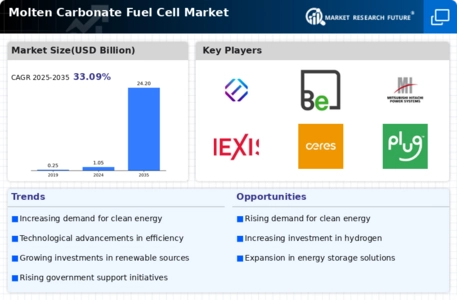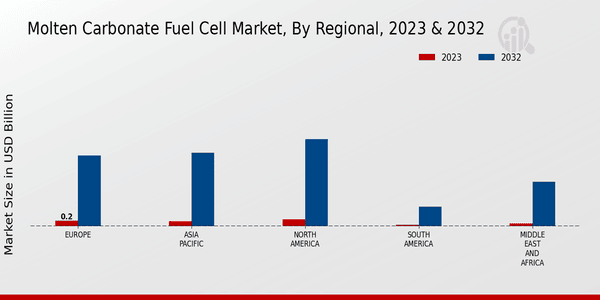Market Growth Projections
The Global Molten Carbonate Fuel Cell Market Industry is projected to experience substantial growth over the next decade. Market analysts anticipate that the industry will expand from a valuation of 1.05 USD Billion in 2024 to an impressive 24.2 USD Billion by 2035. This remarkable growth trajectory is indicative of the increasing adoption of molten carbonate fuel cells across various sectors, driven by technological advancements, government support, and rising demand for clean energy solutions. The projected compound annual growth rate of 33.04% from 2025 to 2035 underscores the potential for significant market expansion as industries seek sustainable energy alternatives.
Rising Industrial Applications
The rising industrial applications of molten carbonate fuel cells are significantly influencing the Global Molten Carbonate Fuel Cell Market Industry. Industries such as manufacturing, transportation, and power generation are increasingly adopting fuel cell technologies to enhance energy efficiency and reduce operational costs. For example, several manufacturing plants are integrating molten carbonate fuel cells to provide reliable power while minimizing emissions. This trend indicates a broader acceptance of fuel cells across various sectors, which may contribute to the anticipated market growth. The diversification of applications is likely to play a crucial role in sustaining the momentum of the market in the coming years.
Global Energy Security Concerns
Global energy security concerns are driving interest in alternative energy sources, including molten carbonate fuel cells, within the Global Molten Carbonate Fuel Cell Market Industry. As geopolitical tensions and supply chain vulnerabilities persist, nations are increasingly seeking energy independence through diversified energy portfolios. Fuel cells offer a viable solution by providing a stable and efficient energy source that can be produced locally. This shift towards energy security is likely to enhance the attractiveness of molten carbonate fuel cells, potentially leading to increased investments and market growth as countries prioritize energy resilience.
Government Incentives and Support
Government incentives and support are pivotal in fostering the growth of the Global Molten Carbonate Fuel Cell Market Industry. Various countries are offering financial incentives, tax breaks, and grants to promote the adoption of fuel cell technologies. For instance, the United States Department of Energy has launched initiatives aimed at advancing fuel cell research and commercialization. These supportive measures not only lower the barriers to entry for new technologies but also encourage private sector investment. As a result, the market is expected to expand significantly, potentially reaching 24.2 USD Billion by 2035, as more stakeholders recognize the economic benefits of transitioning to cleaner energy sources.
Increasing Demand for Clean Energy Solutions
The Global Molten Carbonate Fuel Cell Market Industry is witnessing a surge in demand for clean energy solutions as nations strive to meet stringent environmental regulations. The transition towards sustainable energy sources is becoming paramount, with governments implementing policies to reduce carbon emissions. For instance, the European Union has set ambitious targets for carbon neutrality by 2050, which is likely to drive investments in fuel cell technologies. This trend suggests that the market could reach a valuation of 1.05 USD Billion in 2024, reflecting a growing recognition of the role of molten carbonate fuel cells in achieving energy efficiency and sustainability.
Technological Advancements in Fuel Cell Efficiency
Technological advancements are playing a crucial role in enhancing the efficiency of molten carbonate fuel cells, thereby propelling the Global Molten Carbonate Fuel Cell Market Industry forward. Innovations in materials and design are leading to improved performance and durability, which may attract more commercial applications. For example, recent developments in electrolyte materials have shown promise in increasing operational temperatures and reducing degradation rates. Such advancements could potentially contribute to a compound annual growth rate of 33.04% from 2025 to 2035, indicating a robust growth trajectory as industries seek reliable and efficient energy solutions.









